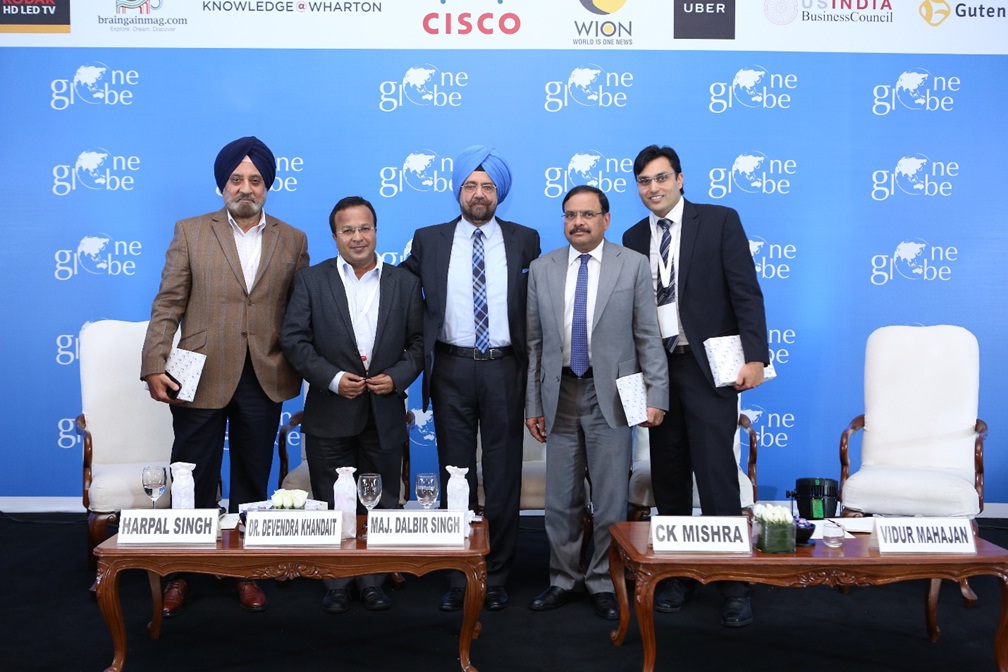Transforming India's public health landscape
Posted by Admin on January 05, 2018

From left, Mr. Harpal Singh (Mentor & Chairman Emeritus, Fortis Healthcare), Dr. Devendra Khandait (India Country Lead, Bill & Melinda Gates Foundation), Mr Dalbir Singh (Chairman, One Globe Forum), Mr. C.K. Mishra (Health Secretary, Government of India), and Dr. Vidur Mahajan (Associate Director, Mahajan Imaging)
 |
India had 2.8 million new cases of TBin 2015 according to the World Health Organisation. Malaria deaths, however, fell to 316 according to the 2014 World Malaria report. In the same year, the burden of non-communicable diseases was at an all-time high, with heart and lung diseases being the top two killer diseases within the country (World Health Statistics Report). According to WHO. if India is unable to lower its disease burden, it might lose up to 4.58 trillion USD between 2012-2030.
To ensure health and combat disease, investment is mandatory. But, in comparison with countries like Brazil, China, and South Africa, India spends a lower percentage of its GDP on healthcare – 4.7% in 2014, according to World Bank reports. India’s Out of Pocket Expense (OPE), on the other hand, is one of the highest in the world.
“India shares 20% of global disease burden today,” said Mr. Dalbir Singh, Senior Advisor, Forum of Federations, Canada, and moderator of the One Globe Forum panel, ‘Transforming India’s Public Health Landscape’. While the country has progressed in technology and medical care, it has lost sight of, and focus on, preventive healthcare.
There is a marked regional disparity in disease, especially communicable ones, which can be easily prevented. But, as Mr. Singh observed, “It is no [longer] romantic to talk of sanitation, hygiene, cleanliness . . . That has led to a spurt in many of these infections.”
Dr. Vidur Mahajan, Associate Director, Mahajan Imaging, said that while government initiatives like the ‘Swachh Bharat Abhiyan’ were strategic, they needed to be incentivized for maximum efficacy.
The panel discussed how many of India’s primary health care subcentres, which cater to populations groups of 3000-5000, have no doctors. As Mr. C.K. Mishra, Union Health Secretary, observed, the government has not “been able to reach everyone with quality. Access has been established, quality is still missing.”
Dr. Devendra Khandait, India Country Lead, Bill & Melinda Gates Foundation, insisted that we must avoid a glass-full or glass-empty approach, when evaluating India’s performance in the healthcare sector. Infant Mortality Rates have dropped 2,100% between 1975 and 2016. Maternal Mortality Rates have also dipped 5.9% between 2009-2016, from 212 per 100,000 live births to 167 per 100,000 live births. According to various indicators, Dr. Khandait argued, India has fared well. However, he agreed that growth in the healthcare sector was not commensurate to that in sectors such as defense, space and internet. And an urgent transformation was necessary.
Mr. Harpal Singh, Mentor & Chairman Emeritus, Fortis Healthcare, said, “My own view – and I’m sure many of you would concur – is that the issue of public health actually is an issue that has cross-domain influence on almost everything that humans are involved with; it doesn’t matter what you are doing.” Therefore, growing the healthcare sector is imperative. In particular, Mr. Mishra added, it has to address three major issues – numbers, skills, and performance. Not only does India need more nurses and General Practitioners, it needs specialists. It also needs to improve the quality of healthcare professionals, through continuous licensing, and rigorous mentoring.
The goal is to provide universal health coverage at affordable costs, and with quality. In other words, access, affordability, and quality are the three basic pillars on which India must build its public health experience.
One way of ensuring universal access without compromising quality is to integrate technology. Dr. Mahajan said, “There is huge talk about India having a dire need for healthcare professionals. ... we need to bring in Artificial Intelligence based technologies.” The simple functions of a GP can be replicated through technologies like IBM Watson.
This can be a game-changing strategy in a populous country like India, with a patchy performance record. Dr. Khandait said, “In my mind, there are only two ways of moving forward. One is the path of relentless incrementalism – we continue to consolidate our gains and aspire for more, more, more. . .The second is . . . transformative innovations or disruptive innovations.”
To achieve this, all hands must be on deck. As Mr. Mishra concluded, “healthcare cannot, and should not, be a concern of the government alone.” At present, the public and private sectors are growing independently. This is the biggest policy malaise in the country. For a true transformation to occur, the growth in both sectors needs to align and converge on national priorities.








